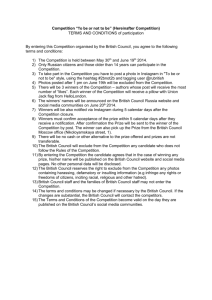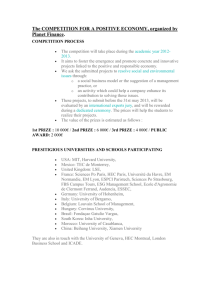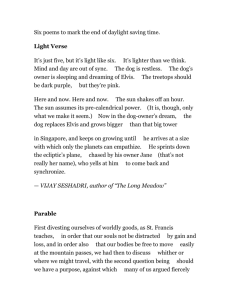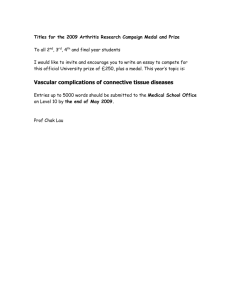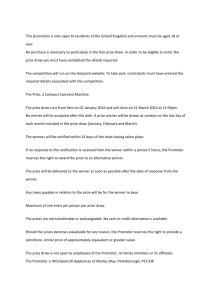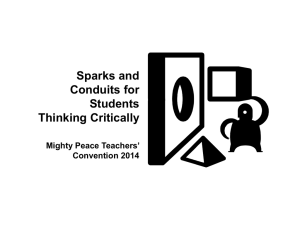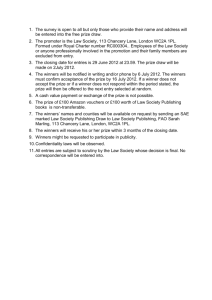Meaning Making - Mighty Peace Teachers' Convention
advertisement
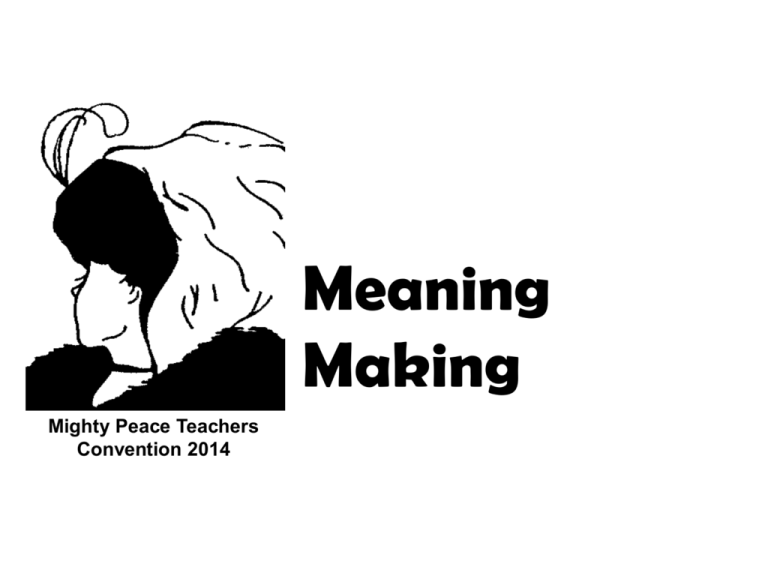
Meaning Making Mighty Peace Teachers Convention 2014 For more conversation: Rick Wormeli 703-620-2447 rwormeli@cox.net @Rickwormeli (Twitter) www.rickwormeli.com Herndon, VA Meaning Matters An English professor wrote the words, “A woman without her man is nothing,” on the blackboard and directed the students to punctuate it correctly. The men wrote: “A woman, without her man, is nothing,” while the women wrote, “A woman: without her, man is nothing.” ---------------------------------------------“Let’s eat, Dad!” “Let’s eat Dad.” (Punctuation saves lives.) “Advocates of homework are fond of pointing out that you don’t get to be proficient at activities like tennis or basketball without spending an awful lot of time practicing. But even here, what matters most is the fact that the wouldbe athlete wants to be out on the court. Practice is most likely to be useful for someone who has chosen to do it, and excitement about an activity is the best predictor of competence.” (Kohn, p. 116) “To a person uninstructed in natural history, his country or seaside stroll is a walk through a gallery filled with wonderful works of art, nine-tenths of which have their faces turned to the wall.” -- Thomas Huxley, 1854 Expertise increases engagement and understanding. (Physics students example) ‘Put another way: Chance favors the prepared mind. -- Pasteur Yes, teach students to memorize content. Which one leads to more learning of how microscopes work? 1. Kellen plays with the microscope, trying out all of its parts, then reads an article about how microscopes work and answers eight comprehension questions about its content. 2. Kellen reads the article about how microscopes work, answers eight comprehension questions about its content, then plays with the microscope, trying out all of its parts. Perception • What do you see? • What number do you see? • What letter do you see? Perception is when we bring meaning to the information we receive, and it depends on prior knowledge and what we expect to see. (Wolfe, 2001) Are we teaching so that students perceive, or just to present curriculum and leave it up to the student to perceive it? Worthy they were, Rafael, Leonardo, Michelangelo, and Donatello. Theirs’ a chromatic and plumed rebirth, ‘A daring reflection upon man. Beyond Hastings and a Wife’s tale in Canterbury, Galileo thrust at more than Windmills, He, Copernicus Gravitas. And for the spectre of debate, religion blinked then jailed, errant no more, thereby errant forever. Cousin to Pericles, Son of Alexander, The cosmology of Adam fanned for all, feudal plains trampled by trumpeters, man and woman lay awake -calves on wobbly legs, staring at new freedom and Gutenberg’s promise. The Brain’s Dilemna: What Input to Keep, and What Input to Discard? • Survival • Familiarity/Context • Priming • • • • Intensity Emotional Content Movement Novelty -- Summarized from Pat Wolfe’s Brain Matters, 2001 Prime the brain prior to asking students to do any learning experience. Priming means we show students: 1) What they will get out of the experience (the objectives) 2) What they will encounter as they go through the experience (itinerary, structure) Creating Background Where There is None • Tell the story of the Code of Hammurabi before discussing the Magna Charta. • Before studying the detailed rules of baseball, play baseball. • Before reading about how microscopes work, play with micros copes. • Before reading the Gettysburg Address, inform students that Lincoln was dedicating a cemetery. Creating Background Where There is None • Before reading a book about a military campaign or a murder mystery with references to chess, play Chess with a student in front of the class, or teach them the basic rules, get enough boards, and ask the class to play. • In math, we might remind students of previous patterns as they learn new ones. Before teaching students factorization, we ask them to review what they know about prime numbers. • In English class, ask students, “How is this story’s protagonist moving in a different direction than the last story’s protagonist?” • In science, ask students, “We’ve seen how photosynthesis reduces carbon dioxide to sugars and oxidizes water into oxygen, so what do you think the reverse of this process called, ‘respiration,’ does?” • Chess masters can store over 100,000 different patterns of pieces in long term memory. Chess players get good by playing thousands of games! • Experts think in relationships, patterns, chunks, novices keep things individual pieces. • Physics experiment in categorization… • Solid learning comes from when students make the connections, not when we tell them about them. Important for all ages when moving content into long-term memory: Students have to do both, Access Sense-Making Process Meaning-Making Use students’ frame of reference to teach: ‘Chemical bonds taught through kitchen experiments ‘Historical figures portrayed in graphic comics ‘Algebraic calculations used to figure out the force needed in cool physics experiments ‘Plot development explained via favorite role-playing games Help students visualize themselves doing the task/career: Ask scientists, mathematicians, architects, police officers, x-ray technicians, diplomats, judges, nutritionists, and cartographers to visit the classroom and bring equipment from their respective fields. Ask them to describe typical days, processes, and the positives of their work. If possible, have a few students visit with them in their work places and report back. O C Low quality, students are passive, learning has no meaning, students do not achieve High quality, students are active, learning has meaning, students achieve [Based on an idea by the author, Avi] Three elements in intrinsic motivation: • Autonomy -- the ability to choose what and how tasks are completed • Mastery -- the process of becoming adept at an activity • Purpose -- the desire to improve the world. -- Daniel H. Pink Drive: The Surprising Truth about What Motivates Us 2009 Characteristics of Motivational Classrooms (Rick Lavoie, The Motivation Breakthrough, 2007) 1. Relevance 2. Control 3. Balance of Support and Challenge 4. Social Interaction 5. Safety and Security Motivational Forces (Needs): To Belong To be Independent To be Important To Know To be Acknowledged To Control To Assert Unique Needs of Young Adolescents 1. Structure and clear limits 2. Physical activity every single day 3. Frequent and meaningful experiences with fine and performing arts 4. Opportunities for self-definition 5. Safe and inviting emotional atmosphere 6. Experiences in with real competence 7. Meaningful participation in families, school, and communities 8. Basics: food, water, rest, good health, physical presence. 9. To belong Vividness • “a lot” – Running to each wall to shout, “a” and “lot,” noting space between • Comparing Constitutions – Former Soviet Union and the U.S. – names removed • Real skeletons, not diagrams • Simulations • Writing Process described while sculpting with clay If I had been a kid in my class today, …would I want to come back? -- Elsbeth Murphy, Chalkdust, 1979 “The Inner Net” - David Bowden “Learning is fundamentally an act of creation, not consumption of information.” - Sharon L. Bowman, Professional Trainer CONSTRUCTIVISM Traditional Learning Constructivist Learning • Part to whole, emphasize skills • Whole to part, emph. concepts • Strict adherence to curriculum • Pursue student questions • Rely on textbooks, workbooks • Rely on prim. sources, manip. • Students are “blank slates” • Students are thinkers • Teachers disseminate info • Teachers mediate, interact • Teachers seek correct answer to validate learning • Teachers seek students’ knowledge to make decisions • Assessment/Teaching separate • Assessment/Teaching are interwoven To create meaning in students’ learning experiences: • Connect new learning to previous learning • Connect new learning to students’ backgrounds - Sousa: “If we expect students to find meaning, we need to be certain that today’s curriculum contains connections to their past experiences, not just ours.”(p. 49) • Model how the skill or concept is used • Demonstrate how the content or skills create leverage (how it gains us something) in other subjects • Include a, “So, why should we learn this?” section in every major lesson • Increase the emotional connections • Create more access points in the mind • Prime the brain • Separate and combine knowledge: analyze, synthesize “You have to remember that real learning happens best in two ways: Students summarize/process their learning frequently, and they use that information and those skills outside the classroom. If we do both with students, they learn more. If we teach them proper letter format, they write real postal letters. If we teach them fractions, they use those fractions to build something.” – Rick Wormeli’s cooperating teacher when he was student teaching, 1980 Lkdsja;lkdsj Vividness • “a lot” – Running to each wall to shout, “a” and “lot,” noting space between • Comparing Constitutions – Former Soviet Union and the U.S. – names removed • Real skeletons, not diagrams • Simulations • Writing Process described while sculpting with clay Body Analogies • Fingers and hands can be associated with dexterity, omnidirectional aspects, working in unison and individually, flexibility, or artwork. • Feet can relate to things requiring “footwork” or journey. • Anything that expresses passion, feeling, pumping, supplying, forcing, life, or rhythm could be analogous to the heart. • Those concepts that provide structure and/or support for other things are analogous to the spinal column. Body Analogies • Those things that protect are similar to the rib cage and cranium. • The pancreas and stomach provide enzymes that break things down, the liver filters things, the peristalsis of the esophagus pushes things along in a wave-like muscle action. • Skin’s habit of regularly releasing old, used cells and replacing them with new cells from underneath keeps it healthy, flexible, and able to function. Journalistic vs. Encyclopedic Writing “The breathing of Benbow’s pit is deafening, like up-close jet engines mixed with a cosmic belch. Each new breath from the volcano heaves the air so violently my ears pop in the changing pressure – then the temperature momentarily soars. Somewhere not too far below, red-hot, pumpkin size globs of ejected lava are flying through the air.” -- National Geographic, November 2000, p. 54 “A volcano is a vent in the Earth from which molten rock (magma) and gas erupt. The molten rock that erupts from the volcano (lava) forms a hill or mountain around the vent. Lava may flowout as viscous liquid, or it may explode from the vent as solid or liquid particles…” -- Global Encyclopedia, Vol. 19 T-U-V, p. 627 The Gettysburg Address Four score and seven years ago our fathers brought forth on this continent, a new nation, conceived in Liberty, and dedicated to the proposition that all men are created equal. Now we are engaged in a great civil war, testing whether that nation, or any nation so conceived and so dedicated, can long endure. We are met on a great battle-field of that war. We have come to dedicate a portion of that field, as a final resting place for those who here gave their lives that that nation might live. It is altogether fitting and proper that we should do this. But in a larger sense, we can not dedicate -- we can not consecrate -- we can not hallow -this ground. The brave men, living and dead, who struggled here, have consecrated it, far above our poor power to add or detract… Chronological Order Definition and Key words: This involves putting facts, events, a concepts into sequence using time references to order them. Signal words include on (date), now, before, since, when, not long after, and gradually. “Astronomy came a long way in the 1500s and 1600s. In 1531, Halley’s Comet appeared and caused great panic. Just twelve years later, however, Copernicus realized that the sun was the center of the solar system, not the Earth, and astronomy became a way to understand the natural world, not something to fear. In the early part of the next century, Galileo made the first observations with a new instrument – the telescope. A generation later, Sir Issac Newton invented the reflecting telescope, a close cousin to what we use today. Halley’s Comet returned in 1682 and it was treated as a scientific wonder, studied by Edmund Halley.” Compare and Contrast Defintion and Key words: Explains similarities and differences. Signal words include however, as well as, not only, but, while, unless, yet, on the other hand, either/or, although, similarly, and unlike. “Middle school gives students more autonomy than elementary school. While students are asked to be responsible for their learning in both levels, middle school students have more pressure to follow through on assignments on their own, rather than rely on adults. In addition, narrative forms are used to teach most literacy skills in elementary school. On the other hand, expository writing is the way most information is given in middle school.” Cause and Effect Definition and Key words: Shows how something happens through the impact of something else. Signal words include because, therefore, as a result, so that, accordingly, thus, consequently, this led to, and nevertheless. “Drug abusers often start in upper elementary school. They experiment with a parent’s beer and hard liquor and they enjoy the buzz they receive. They keep doing this and it starts taking more and more of the alcohol to get the same level of buzz. As a result, the child turns to other forms of stimulation including marijuana. Since these are the initial steps that usually lead to more hardcore drugs such as Angel Dust (PCP), heroin, and crack cocaine, marijuana and alcohol are known as “gateway drugs.” Because of their addictive nature, these gateway drugs lead many youngsters who use them to the world of hardcore drugs.” Problem and Solution Definition and Key words: Explains how a difficult situation, puzzle, or conflict develops, then what was done to solve it. Signal words are the same as Cause and Effect above. “The carrying capacity of a habitat refers to the amount of plant and animal life its resources can hold. For example, if there are only 80 pounds of food available and there are animals that together need more than 80 pounds of food to survive, one or more animals will die – the habitat can’t “carry” them. Humans have reduced many habitats’ carrying capacity by imposing limiting factors that reduce its carrying capacity such as housing developments, road construction, dams, pollution, fires, and acid rain. So that they can maintain full carrying capacity in forest habitats, Congress has enacted legislation that protects endangered habitats from human development or impact. As a result, these areas have high carrying capacities and an abundance of plant and animal life.” Proposition and Support Defintion and Key words: The author makes a general statement followed by two or more supporting details. Key words include: In addition, also, as well as, first, second, finally, in sum, in support of, therefore, in conclusion. “There are several reasons that teachers should create prior knowledge in students before teaching important concepts. First, very little goes into long-term memory unless it’s attached to something already in storage. Second, new learning doesn’t have the meaning necessary for longterm retention unless the student can see the context in which it fits. Finally, the brain likes familiarity. It finds concepts with which it is familiar compelling. In sum, students learn better when the teacher helps students to create personal backgrounds with new topics prior to learning about them. Enumeration Definition and Key words: Focuses on listing facts, characteristics, or features. Signal words include to begin with, secondly, then, most important, in fact, for example, several, numerous, first, next finally, also, for instance, and in addition. “The moon is our closest neighbor. It’s 250,000 miles away. It’s gravity is only 1/6 that of Earth. This means a boy weighing 120 pounds in Virginia would weigh only 20 pounds on the moon. In addition, there is no atmosphere on the moon. The footprints left by astronauts back in 1969 are still there, as crisply formed as they were on the day they were made. The lack of atmosphere also means there is no water on the moon, an important problem when traveling there.” When connections form knowledge structures that are accurately and meaningfully organized, students are better able to retrieve and apply their knowledge effectively and efficiently. In contrast, when knowledge is connected in inaccurate or random ways, students can fail to retrieve or apply it appropriately. (Carnegie Melon) Meaningful Arrangement and Patterns are Everything d-a-o-o-u-i-d-y-v-l-e “I love you, Dad.” Meaningful Arrangement and Patterns are Everything CP RUSA Narrowing the Topic The Civil War People Battles Inventions Reasons Is the topic narrow enough to be focused, but broad enough to have plenty to write about? Battles of the Civil War Gettysburg Manassas Antietam Vicksburg Is the topic narrow enough to be focused, but broad enough to have plenty to write about? Battles of Gettysburg Statistics Geography Famous People Strategies Is the topic narrow enough to be focused, but broad enough to have plenty to write about? What was the “Fish hook” strategy used at the Battle of Gettysburg? Yeah. That’s it. Students looking for patterns Add these numbers: 296, 302, 299, 320 Each is close to 300, so identify the relationship to 300: -4, +2, -1, +20 = -5 + 22 = +17 (300 x 4) + 17 = 1,217 Jamie's homework assignment requires her to write a short biography of five female Nobel Prize winners. Help her match each nobelist to her prize category, country of origin and the year in which she won her prize. Below are all categories and options used in this puzzle: Years Names Categories Countries 1968 1972 1976 1980 1984 chemistry economics literature medicine physics Australia France Germany Poland Russia Ada Alvarez Fay Ferguson Glenda Glenn Hannah Hay Patsy Pope Downloaded February 2013 from www.logic-puzzles.org Clues: 1. Fay Ferguson is from Australia. 2. The person from Australia didn't win the prize in literature. 3. The nobelist who won in 1968 didn't win the prize in chemistry. 4. Of the nobelist who won the prize in medicine and Ada Alvarez, one won in 1984 and the other won in 1972. 5. The winner from Poland won her prize 4 years after the nobelist from Australia. 6. Patsy Pope won her prize after the winner who won the prize in chemistry. 7. Neither Fay Ferguson nor the winner who won the prize in economics is the winner who won in 1984. 8. The nobelist from Germany won her prize 4 years after the winner from France. 9. Glenda Glenn isn't from France. 10. The person who won in 1976 didn't win the prize in literature. 11. The five nobelists are the nobelist from France, the winner who won in 1972, Hannah Hay, the winner who won in 1968 and the winner who won in 1980. We think primarily in physical terms. Over time we become adept at translating symbolic and abstract concepts into meaningful structures or experiences. Have Some Fun – Anything Can Be A Metaphor! An apple • • • • • • a star (the birth place of energy on our planet) in the middle (the seed pattern makes a star if we cut it the right way) we must break the surface to get to the juicy good parts the outside doesn’t reveal what lies inside the apple becomes soft and mushy over time the apple can be tart or sweet depending on its family background its parts are used to create multiple products A cell phone • • • • • • • • • lifeline to the larger world an unapologetic taskmaster an unfortunate choice of gods a rude child that interrupts just when he shouldn’t a rite of passage a declaration of independence a secret language encoder (text messaging abbreviations unknown to adults) delineation of generations A pencil sharpener • • • • • • • Whittler of pulp Tool diminisher Mouth of a sawdust monster Eater of brain translators Cranking something to precision Writing re-energizer Scantron test enabler Curtains • • • • • • • Wall between fantasy and reality Denied secrets Anticipation Arbiter of suspense Making a house a home Vacuum cleaner antagonist Cat’s “Jungle Gym” Railroad • Circulatory system of the country • • • • • • • • • • Enforcer of Manifest Destiny Iron monster Unforgiving mistress to a hobo Lifeline Economic renewal Relentless beast Mechanical blight Movie set A foreshadow of things to come A hearkening to the past Metaphors Break Down “You can’t think of feudalism as a ladder because you can climb up a ladder. The feudal structure is more like sedimentary rock: what’s on the bottom will always be on the bottom unless some cataclysmic event occurs.” -- Amy Benjamin, Writing in the Content Areas, p. 80 Same Concept, Multiple Domains The Italian Renaissance: Symbolize curiosity, technological advancement, and cultural shifts through mindmaps, collages, graphic organizers, paintings, sculptures, comic strips, political cartoons, music videos, websites, computer screensavers, CD covers, or advertisements displayed in the city subway system. The economic principle of supply and demand: What would it look like as a floral arrangement, in the music world, in fashion, or dance? Add some complexity: How would each of these expressions change if were focusing on a bull market or the economy during a recession? Same Concept, Multiple Domains Geometric progression, the structure of a sentence, palindromes, phases of the moon, irony, rotation versus revolution, chromatic scale, Boolean logic, sine/cosine, meritocracy, tyranny, feudalism, ratios,the relationship between depth and pressure, musical dynamics, six components of wellness, and the policies of Winston Churchill can all be expressed in terms of: food, fashion, music, dance, flora, fauna, architecture, minerals, weather, vehicles, television shows, math, art, and literature. Common Analogous Relationships • • • • • • • • • • • • • • • • Antonyms Synonyms Age Time Part : Whole Whole : Part Tool : Its Action Tool user : Tool Tool : Object It’s Used With Worker: product he creates Category : Example Effect : Cause Cause : Effect Increasing Intensity Decreasing Intensity Person : closely related adjective • • • • • • • • • • • • • • • Person : least related adjective Math relationship Effect : cause Action : Thing Acted Upon Action : Subject Performing the Action Object or Place : Its User Object : specific attribute of the object Male : Female Symbol : what it means Classification/category : example Noun : Closely Related Adjective Elements Used : Product created Attribute : person or object Object : Where it’s located Lack (such as drought/water – one thing lacks the other) Great Resources on Metaphors • From Molecule to Metaphor: A Neural Theory of Language by Jerome Feldman • Metaphor: A Practical Introduction by Zoltan Kovecses • Poetic Logic: The Role of Metaphor in Thought, Language, and Culture by Marcel Danesi • Metaphors & Analogies: Power Tools for Teaching any Subject by Rick Wormeli • I Is an Other: The Secret Life of Metaphor and How It Shapes the Way We See the World by James Geary Great Resources on Metaphors • Metaphors We Live By by George Lakoff • The Political Mind: Why You Can't Understand 21stCentury American Politics with an 18th-Century Brain by George Lakoff • A Bee in a Cathedral: And 99 Other Scientific Analogies by Joel Levy • On Metaphor (A Critical Inquiry Book) edited by Sheldon Sacks Inquiry Method 1. Something arouses students’ curiosity. 2. Students identify questions regarding topic. There is usually one main question with several sub-questions that help answer the main question. These questions are submitted to classmates for review. 3. Students determine the process of investigation into topic. Their proposal for how to conduct the investigation is submitted to classmates for review and revision as necessary. 4. Students conduct the investigation. 5. Students share their findings. Socratic Seminar Pre-Seminar: A. Shared experiences, chosen for richness of ideas, issues, ambiguity, “discussability” B. Students reflect on material Group dynamics, ground rules, and courtesy are understood and accepted. Seminar: A. Teacher asks a provocative question. Opening, Core, and Closure Questions B. Students respond to the provocative question and each other. C. Teacher offers core questions that help students interpret and to re-direct, also evalutes and tries to keep mouth shut. C. Closing – connect to the real world of the student Post-Seminar Writings, Summations, Artwork, Reflection, Critique, Analysis Debate Format 1. Statement of the General Debate Topic and Why it’s Important – 1 min. 2. Affirmative Position Opening Remarks – 3 min. 3. Negative Position Opening Remarks – 3 min. 4. Affirmative Position Arguments – 5 min. 5. Negative Position Arguments – 5 min. 6. Caucus – Students on both teams consider their arguments and rebuttals in light of what has been presented. – 3 min. 7. Affirmative Rebuttal and Questioning of the Negative’s Case – 3 min. 8. Negative Rebuttal and Questioning of the Affirmative’s Case – 3 min. 9. Closing Arguments Affirmative Position – 2 min. 10. Closing Arguments Negative Position – 2 min. Meeting of Minds at Rachel Carson Middle School Portrayals of Dr. Sally Ride, Albert Einstein, Josef Stalin, Bob Dylan, Boss Tweed, Dr. Robert Oppenheimer, Senator Joseph McCarthy, the Unsinkable Molly Brown, Rosa Parks. In the background: Advisors for each historical figure Quick Reference: Differentiated Lesson Planning Sequence A. Steps to take before designing the learning experiences: 1. Identify your essential understandings, questions, benchmarks, objectives, skills, standards, and/or learner outcomes. 2. Identify your students with unique needs, and get an early look at what they will need in order to learn and achieve. 3. Design your formative and summative assessments. 4. Design and deliver your pre-assessments based on the summative assessments and identified objectives. 5. Adjust assessments or objectives based on your further thinking discovered while designing the assessments. Learner Profile: Any Factor that might Influence Learning Family dynamics (if influential) SES 504 LD Physical health Speech and Language Issues Nationality (if influential) Religious affiliation (if influential) Multiple Intelligences Personal background/experiences Ethics Personal interests: sports, music, television, movies, books, hobbies, other Myers-Briggs Personality Inventory Bernice McCarthy’s 4MAT Tourette’s Syndrome Down’s Syndrome Visually Impaired Transiency rate IEP ELL Gifted/Advanced Emotional health Behavior/Discipline concerns Diet (if influential) Technology access/comfort Arts – comfort/profiency Leadership qualities Collaboration Weekly schedule Politics (if influential) Anthony Gregorc Scale Home responsibilities ADHD Asperger’s Syndrome Hearing Impaired Auditory Processing issues Quick Reference: Differentiated Lesson Planning Sequence B. Steps to take while designing the learning experiences: 1. Design the learning experiences for students based on preassessments, your knowledge of your students, and your expertise with the curriculum, cognitive theory, and students at this stage of human development. 2. Run a mental tape of each step in the lesson sequence to make sure things make sense for your diverse group of students and that the lesson will run smoothly. 3. Review your plans with a colleague. 4. Obtain/Create materials needed for the lesson. 5. Conduct the lesson. 6. Adjust formative and summative assessments and objectives as necessary based on observations and data collected while teaching. When Designing your Actual Lessons…. 1. Brainstorm multiple strategies 2. Cluster into introductory, advanced, and strategies that fit between these two 3. Sequence activities in plan book 4. Correlate Class Profile descriptors, expertise in students at this age, Differentiation Strategies, and Cognitive Science Principles to lessons – What do you need to change in order to maximize instruction for all students? Quick Reference: Differentiated Lesson Planning Sequence C. Steps to take after providing the learning experiences: 1. Evaluate the lesson’s success with students. What evidence do you have that the lesson was successful? What worked and what didn’t, and why? 2. Record advice on lesson changes for yourself for when you do this lesson in future years. “Learning is not about soaking in knowledge; instead, it’s about changing the knowledge into something meaningful for the learner who is processing it.” -- Jensen, Nickelsen, p.111
